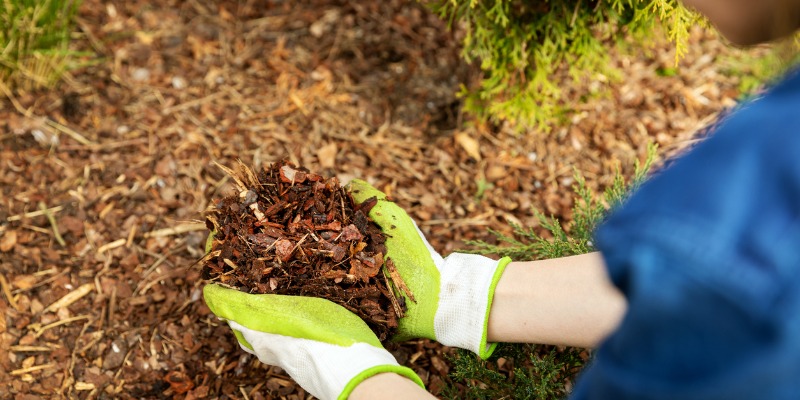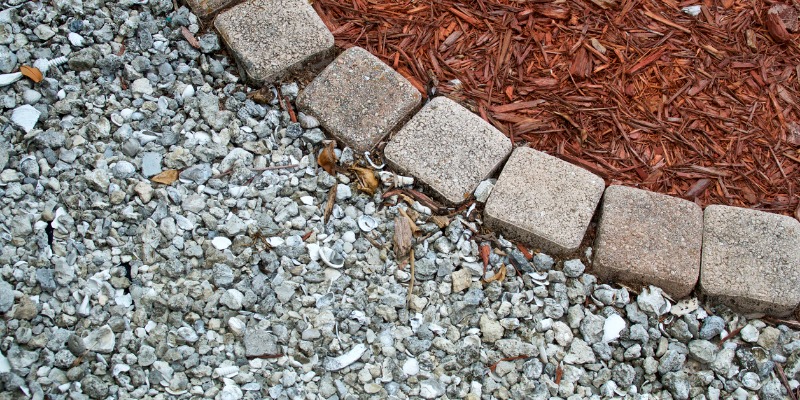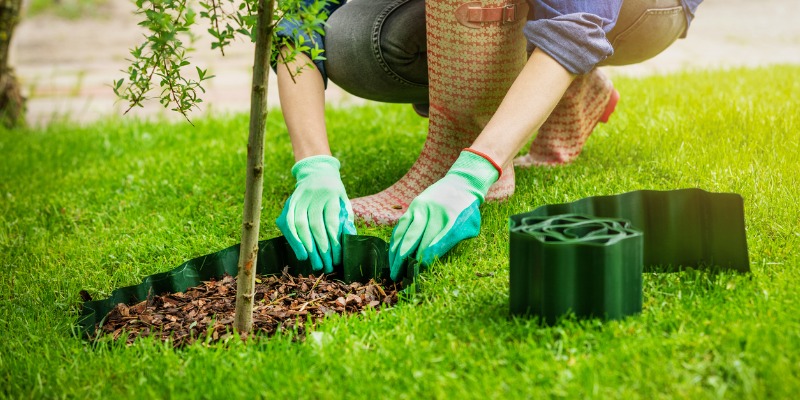Mulch 101: Everything You Need to Know is Right Here
Mulch is a popular, attractive, and affordable garden detail designed to keep weeds at bay and protect garden beds. There are many different types of mulch, which can make it a little overwhelming when choosing the best one for your landscaping project. Here we offer a complete overview of what type of mulch is best for landscaping and everything you need to know when using it.
Different Types of Mulch
The different types of mulch each have their own benefits and recommended uses. There are completely natural types of mulch for flower beds such as cedar mulch and pine mulch, as well as mulches designed for a particular look, such as red-dyed mulch and black-dyed mulch. When choosing what type of mulch is best for landscaping, you can consider the following options:
Pine and Cedar Mulch
This is the best type of mulch if you want a 100% natural product for your garden beds. It is attractive, yet blends into flower beds without making too much of a statement. One of the reasons we recommend this type of mulch over pine or cedar chips is that it is shredded and tends to stay in place better than the larger pieces found in chip-style mulch. So this is also your better choice if you are gardening in a sloped area.
Red and Black Dyed Mulch
If you want to make more impact in the design of your garden beds, this is the best type of mulch. The colour draws more attention to your garden beds, creating a lovely accent. Another benefit of dyed mulch is that it holds its colour longer, so you might find you don’t need to replace it or top it up as often as you would with basic shredded mulches. Instead, you can just update it when needed to make up for fading or volume loss over the winter months.
Economy Mulches
If you are adding mulch for practical purposes, the best type of mulch is an economy mix. These mulches are a little chunkier than the shredded mixes, but not so large that they will shift as much as chips and nuggets.
Stone and Rocks
This is the best type of mulch if you want something more permanent. Stone is an option when you want something decorative. Larger stones like river rock can provide an excellent accent and filler if you don’t want to fuss over lawn or plants. It is very low maintenance.
Selecting The Best Type of Mulch
You can easily create the look you want with so many options available. However, you also must consider what you want from your mulch.
When you choose the natural wood mulches, they eventually decompose, which can help improve your soil. However, they are also higher maintenance as they need to be replaced more often. On the other hand, dyed mulches are less maintenance because they won’t fade or break down as quickly. However, some gardeners don’t like the idea of placing dyed mulch in their gardens in case they aren’t as healthy for the soil.
A good rule of thumb to help narrow down your choices is that if your garden is set and you don’t plan to do much more planting or moving plants around, stone, or dyed mulch is best. However, if you do like to mix things up a lot, using organic mulches makes more sense. If you want to use mulch as a filler, or decorative accent stone is always the winner.
Are you looking for help in selecting the perfect mulch for your space? Our team at Grand River Natural Stone would be happy to help. Give us a call today.
How Much Mulch Do You Need?
Now that you have a better idea of which mulch to choose, your next question is probably how much mulch do I need? This is an important question because you don’t want to blow your budget on too much mulch, but don’t want to apply it too sparingly and find it doesn’t do its job. The good news is you can use a mulch calculator. A mulch area calculator just needs a few measurements to determine the square footage of your garden bed using these steps:
Find the Square Footage
For squares/rectangular gardens you simply measure the width and length and multiply them to get the square footage. For circular gardens, you want to hit the center of the bed and measure to the edge. Multiply that number by itself. So if the measurement is 8 ft, you multiple 8 x 8.
Consider the Depth
You also need to consider how deep you want your mulch. A simple rule we recommend is that for trees and shrubs you’ll need three to four inches, and for plants, including vegetables you’ll need from one to three.
Bulk Measurements
When ordering in bulk, you order in yards. So how much is a yard of mulch? Each yard is 27 cubic feet. And how much does a yard of mulch cover? One cubic yard of mulch covers a 324-square-foot area an inch deep. To come up with your bulk measurement, you multiply square footage by the number of inches and then divide that by 324 to calculate your cubic yardage.
Using a mulch coverage calculator will help make sure you order the right amount.
How and When to Lay Mulch
With your order calculated and your mulch delivery in your yard, it’s time to get down to business. Knowing when to use mulch and how to apply mulch to flower beds will ensure you see the best results for your efforts. Here are some basic steps for mulching:
How Deep Should You Spread Mulch?
There was a reason we included how thick you spread mulch when calculating how much you’ll need. If you apply it too thinly, it won’t shade your plant’s roots on steamy hot days, stop weeds from finding a place to root, and help prevent moisture in your soil from evaporating. If it’s too thick, it can lead to breathing issues for the soil, and also attract garden pests. The ideal thickness is one to three inches for plants and three to four inches for shrubs and trees.
When Is The Best Time To Mulch Your Garden?
In theory, there isn’t a specific time to add mulch to flower beds. You can top up mulch any time of year it looks a little sparse, and you can also apply mulch whenever you create new garden beds.
When to Mulch for Winter
Since we live in an area where the cold freezes the soil, it is best to apply mulch in the fall. However, wait until the ground freezes before you apply it. If you are wondering when it is too late to mulch, the answer is, when it snows. This just makes it impossible to mulch, so get your mulching done in the fall or early winter as soon as the ground is frozen.
How to Mulch Plants
Your plants need to have a few inches of space of free soil to reduce the risk for rot while also preventing rodents from burrowing under the mulch and chomping at the roots.
What About Mulching Trees and Shrubs?
You might have noticed neighbours have mulched their trees or shrubs as a decorative touch. Mulch is decorative; however, it is also an excellent way to protect your trees. It provides a nice border that keeps your mowers and trimmers away from the trunk. The proper way to apply mulch is to get it to spread evenly without going above 4 inches. Remember to never pile it high over the trunk as this can cause diseases and attract pests.
Are you looking to purchase mulch for your landscaping needs? We have just what you need. Shop our online store today or give our team a call.
How to Maintain Mulch
Last but not least, you’ll need to know how to maintain mulch. Your mulch maintenance will depend on the type of mulch you choose. As mentioned, the dyed mulches and stone will be more maintenance-free than your organic mulches. However, there are still some tips you can use to keep your mulch working hard:
How To Maintain Mulch Beds
Maintaining mulch beds requires a few steps:
Keep An Eye on Colour: If you used dyed mulch, it would take longer to fade than organic mulches. However, it will start to lose its colour after a few years. When you notice your mulch colour has faded you can add a fresh thin layer of mulch as long as you don’t notice any of the following issues:
- The mulch is quite damp even though the weather has been dry
- The mulch shows signs of rotting
- The layer is quite thick
If you have mulch with any of these issues, you’ll actually need to remove it and replace it. When it’s in good condition, be sure to just add enough to refresh the colour keeping in mind our guidelines for mulch depth.
Weed Upkeep: Although your mulch will help defend your garden beds from weeds, there is still a chance they’ll find a way to root. If you are noticing more weeds, it could be a sign your mulch is too thin. Remove the weeds, including the roots and check the depth of your mulch. If it’s less than an inch deep, add a new layer to top it up to reach two to three inches.
Turn Your Mulch: Old mulch needs to be turned and mixed to break up clumps. When it becomes too compact it can interfere with drainage and light. Use a rake to mix it up or even your hands wearing gloves. Be sure to avoid pushing the mulch too close to plants and if it seems thin add a new layer.
Keep Topping It Up: Thin mulch is a recurring theme for all these tips. You want to pay attention to depth and top your mulch up when it seems thin. Doing this twice a year in the mid to late spring and late fall will help keep the layer ideal. In the spring if you notice any of the issues mentioned for dyed mulch, instead of a top-up you’ll need to remove the old mulch and replace it.
How To Store Mulch
Whether you bought your mulch in bulk or bagged, your goal is to keep it dry. The best way to store mulch long-term is to spread it evenly on a dry tarp and then cover it with another tarp. Find a dry spot to lay it and make sure the outer edges of the tarp are loose, so the mulch gets air circulation to reduce moisture. This will help prevent fungal growth.
Are you looking to purchase mulch and transform your yard into your dream space? Our team at Grand River Natural Stone would be happy to help. Give us a call today.


